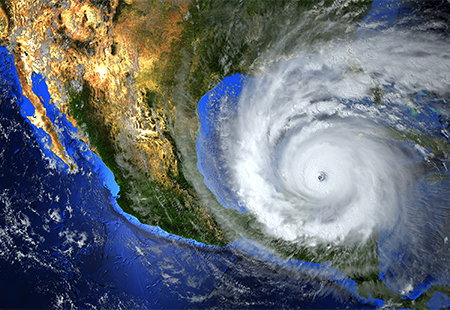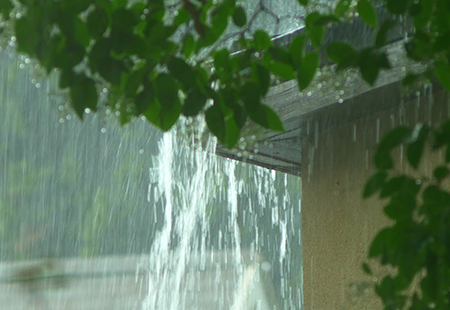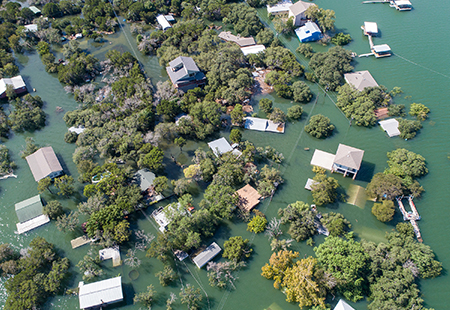Reducing Risk from Corroded Fasteners in Hurricane Zones
October 16, 2020 in Tech Alert
categories

Each year, as hurricane season approaches and passes, we are reminded of the vulnerability of our coastal communities (and the structures throughout these communities). The integrity of structures located in hurricane zones is often tested during such times. Sadly, some do not pass said tests.
As weather patterns grow increasingly more extreme, it’s important to know how certain structural connectors (and their potential deterioration) present significant risks to property in hurricane zones.
This Tech Alert will examine the unique challenges structural connectors in hurricane zones face and what contractors and developers need to know and do to reduce the risk of liability.
The Challenge
Light frame construction within coastal areas requires special attention be paid to the selection of structural connectors, their attachment, and embedment. Because coastal areas are battered by high humidity, salt particles in the air, and constant storm surges, construction components and the fasteners used to secure them have the potential to severely corrode. In fact, selecting the wrong type of structural fastener and/or connectors can be fatal to light frame construction in coastal regions, especially during a hurricane.
Dwelling failures are still being linked to certain fabricated structural components. And while Simpson Strong-Tie Company and MiTek both acknowledge this issue in their product catalogs, the courts recently dismissed a case that would have made the manufacturer liable for such failures. This means builders are potentially liable for fastener and connector troubles. To reduce potential risk and protect home builders from lawsuits down the road, proper selection and installation of hurricane fasteners — and frankly, any fastener — is crucial.
What to Know
Because galvanic corrosion is such a formidable enemy — particularly in unprotected areas or areas partially protected where saltwater spray or salt air is present — galvanized materials should generally be avoided in coastal regions. Use of stainless steel 304, 305, or 316 is preferred in oceanfront areas, but even these metals require periodic inspections for deterioration when exposed to the elements.
However, in protected wall assemblies, the use of galvanized components and fasteners are acceptable. These areas have little exposure to the elements during construction and will be protected after the installation of the dwelling weather-resistive barrier and interior wall coverings. In non-inhabited and ventilated attic areas, a combination of both types of structural components and fasteners can be used. But exercise caution, since salt air movement will be occurring. Any area that has or will be subject to non-protected air movement should use stainless steel structural components and fasteners.

Wood treatment matters, too. Some treatments are known to accelerate the corrosion process of metals when combined with salt and moisture. Today, most wood members are treated with one of the following chemicals: Propiconazole, Triadimefon, Acid Copper Chromate (ACC), Alkaline Copper Quaternary (ACQ), Disodium Octaborate Tetrahydrate (Borate), Copper Azole, Copper Naphthenate, and Copper HDO. Some of these are prohibited from having direct water contact, while for others direct water contact is allowed. A light wood frame structure within a coastal area may contain multiple types of treated wood. Therefore, it is important to ensure the installed structural fasteners and metal structural components are compatible with the wood treatment used to prevent accelerated corrosion of the fastener, structural plate, and/or the structural strap.
Another way to protect connectors from corrosion is to encase them in concrete. But even in concrete, salt air and saltwater can still seep in. Be sure to understand how the type of concrete and its ingredients contribute to protection (or lack of protection) for your connectors and fasteners. For this method to be effective, the amount of concrete cover is dictated by code minimums for the type of exposure. The current edition of the International Residential Code requires concrete in residential applications to be a minimum design strength of 3,000 (PSI) when exposed to severe weather conditions.
The bottom line?
Precisely how you install connectors and fasteners matters. Be sure to understand the impact of the methods and materials you specify.
Some guidelines to follow:
- The use of galvanized components is acceptable as long as there is an understanding that they will eventually require replacement when the galvanizing agent erodes away. Monitoring should occur to ensure moisture and salt air aren’t entering any air cavities where galvanized components are installed.
- The installed structural hardware should be inspected prior to concrete encapsulation to verify it meets the protective finish requirements from the plans and specifications.
- To combat the corrosive process within concrete, the use of an alternate concrete mixture, use of epoxy-coated reinforcing steel, and employing a maintenance program where sealant or a coating is applied to concrete surfaces that are subject to salt-infused air must be considered.
- A structure’s weather-resistive barrier should be installed per manufacturer installation guidelines. (Improper installation is one of the leading causes of water damage to structures.) Where manufacturer guidelines are not present, installation needs to conform to the localized building code requirements.
- Improper maintenance of a structure will lead to premature failure. Therefore, it is imperative that exterior coverings be maintained to prevent the salt-charged air, moisture, and water from entering the structure framed wall assemblies and attacking structural components. When structural components in coastal regions do fail, then those components should be reviewed to determine what caused their failure.

What to Do
Because it can take years for problems to show up, the best way to prevent issues is with proper planning and third-party confirmation of proper installation.
We recommend conducting a plan review in the design phase before construction starts to ensure your selection of materials is appropriate for the conditions of the region.
Once construction starts, enlist the help of an independent expert such as Quality Built to provide quality assurance checks and, where necessary, subcontractor training and oversight.
Building in coastal environments is challenging. That’s why Quality Built offers a range of proactive technical services, special inspection, and forensic services specific to these areas. We can assist with a review of the plans and specifications focused on corrosion factors and offer guidance on potentially problematic conditions. Our field consultants are equipped to inspect installed structural hardware prior to concrete encapsulation and verify it meets the protective finish requirements from the plans and specifications.
Contact us to learn more about how our nationwide network of experts can help protect your next project.
Contact UsReferences:
casetext.com
American Galvanizers Association
National Oceanic and Atmospheric Administration – U.S. Department of Commerce
The United States Environmental Protection Agency
Federal Emergency Management Agency – Technical Bulletin 8 – June 2019
Cemex
LaFarge
Simpson Strong-Tie
MiTek
ABOUT THE AUTHOR
Mark Crawford, Senior Risk Assessment Specialist
Mark is a civil engineer and a seasoned Project/Program Manager with over 20 years of expertise in the construction industry. Mark has professionally designed and managed vertical construction and civil improvement projects throughout the United States. He has in-depth knowledge in civil engineering and architecture, along with extensive experience in building inspections, building codes, design standards, local ordinances, forensic building failure analysis, construction defects and expert witness testimony.